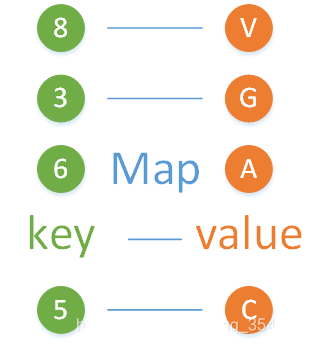数据结构实现 5.2:映射_基于链表实现(C++版)
1. 概念及基本框架
.
在 5.1 中我们通过 二分搜索树 来实现了映射,这一节我们通过 链表 来实现映射。

映射 的基本特性依然要满足:
1.映射内元素包含 键(key) 和 值(value) ,而且一一对应。
2.映射内的元素的键 不能重复 。
注:有些映射(多重映射)中元素的键也可以重复。
在 2.1 中实现的链表结点只有一个数据,所以我们需要从底层进行一些改进去适应映射这一数据结构。首先来定义链表的结点类:
template <class K, class V>
class MapNode{
public:
MapNode(K key = NULL, V value = NULL, MapNode<K, V> *next = NULL){
m_key = key;
m_value = value;
this->next = next;
}
public:
K m_key;
V m_value;
MapNode<K, V> *next;
};
这个结点类的内部也显式的给出了构造函数,下面通过结点类来创建一个映射类。
注:这里我们也可以先实现一个链表类,然后通过链表来实现映射类。
有了改进版的链表结点,我们就可以利用一个由 纯虚函数 构成的 抽象类 作为一个接口来定义这些操作。具体代码如下:
template <class K, class V>
class Map{
public:
virtual int size() = 0;
virtual bool isEmpty() = 0;
//增加操作
virtual void add(K key, V value) = 0;
//删除操作
virtual V remove(K key) = 0;
//修改操作
virtual void set(K key, V value) = 0;
//查找操作
virtual bool contains(K key) = 0;
virtual V get(K key) = 0;
};
下面只需要通过继承 抽象类,并且重写 纯虚函数 ,就可以完成 映射 的实现。映射类的框架如下:
template <class K, class V>
class LinkedListMap : public Map<K, V>{
public:
LinkedListMap(){
head.m_key = NULL;
head.m_value = NULL;
head.next = NULL;
m_size = 0;
}
...
private:
MapNode<K, V> head;
int m_size;
};
这里为了避免重复设计就可以兼容更多数据类型,引入了 泛型 ,即 模板 的概念。(模板的关键字是 class 或 typename)
这里链表加了虚拟头结点,同样,为了保护数据,变量设置为 private 。
实现了前面的程序之后,接下来就是一个映射的增、删、改、查以及一些其他基本操作,接下来利用代码去实现。
2. 基本操作程序实现
2.1 增加操作
template <class K, class V>
class LinkedListMap : public Map<K, V>{
public:
...
//增加操作
void add(K key, V value){
if (!contains(key)){
MapNode<K, V> *p = new MapNode<K, V>(key, value, head.next);
head.next = p;
m_size++;
}
}
...
};
需要查询链表是不是已经包含该键。
2.2 删除操作
template <class K, class V>
class LinkedListMap : public Map<K, V>{
public:
...
//删除操作
V remove(K key){
MapNode<K, V> *pre = &head;
MapNode<K, V> *node = pre->next;
while (node){
if (key == node->m_key){
pre->next = node->next;
V res = node->m_value;
delete node;
m_size--;
return res;
}
pre = node;
node = node->next;
}
cout << "映射中不包含" << key << '!' << endl;
return NULL;
}
...
};
2.3 修改操作
template <class K, class V>
class LinkedListMap : public Map<K, V>{
public:
...
//修改操作
void set(K key, V value){
MapNode<K, V> *node = head.next;
while (node){
if (key == node->m_key){
node->m_value = value;
return;
}
node = node->next;
}
cout << "映射中不包含" << key << '!' << endl;
}
...
};
2.4 查找操作
template <class K, class V>
class LinkedListMap : public Map<K, V>{
public:
...
//查找操作
bool contains(K key){
MapNode<K, V> *node = head.next;
while (node){
if (key == node->m_key){
return true;
}
node = node->next;
}
return false;
}
V get(K key){
MapNode<K, V> *node = head.next;
while (node){
if (key == node->m_key){
return node->m_value;
}
node = node->next;
}
cout << "映射中不包含" << key << '!' << endl;
return NULL;
}
...
};
2.5 其他操作
映射还有一些其他的操作,包括 映射大小 的查询等操作。
template <class K, class V>
class LinkedListMap : public Map<K, V>{
public:
...
int size(){
return m_size;
}
bool isEmpty(){
return m_size == 0;
}
...
};
3. 算法复杂度分析
3.1 增加操作
| 函数 | 最坏复杂度 | 平均复杂度 |
|---|---|---|
| add | O(n) | O(n/2) = O(n) |
因为需要判断是否存在该元素,所以需要遍历一遍整个链表。
3.2 删除操作
| 函数 | 最坏复杂度 | 平均复杂度 |
|---|---|---|
| remove | O(n) | O(n/2) = O(n) |
3.3 修改操作
| 函数 | 最坏复杂度 | 平均复杂度 |
|---|---|---|
| set | O(n) | O(n/2) = O(n) |
3.4 查找操作
| 函数 | 最坏复杂度 | 平均复杂度 |
|---|---|---|
| contains | O(n) | O(n/2) = O(n) |
| get | O(n) | O(n/2) = O(n) |
总体情况:
| 操作 | 时间复杂度 |
|---|---|
| 增 | O(n) |
| 删 | O(n) |
| 改 | O(n) |
| 查 | O(n) |
与利用二分搜索树实现的映射相比,利用链表实现的映射操作的时间复杂度就增大了很多。
4. 完整代码
程序完整代码(这里使用了头文件的形式来实现类)如下。
抽象类 接口代码:
#ifndef __MAP_H__
#define __MAP_H__
template <class K, class V>
class Map{
public:
virtual int size() = 0;
virtual bool isEmpty() = 0;
//增加操作
virtual void add(K key, V value) = 0;
//删除操作
virtual V remove(K key) = 0;
//修改操作
virtual void set(K key, V value) = 0;
//查找操作
virtual bool contains(K key) = 0;
virtual V get(K key) = 0;
};
#endif
映射类 代码:
#ifndef __LINKEDLISTMAP_H__
#define __LINKEDLISTMAP_H__
#include "Map.h"
template <class K, class V>
class MapNode{
public:
MapNode(K key = NULL, V value = NULL, MapNode<K, V> *next = NULL){
m_key = key;
m_value = value;
this->next = next;
}
public:
K m_key;
V m_value;
MapNode<K, V> *next;
};
template <class K, class V>
class LinkedListMap : public Map<K, V>{
public:
LinkedListMap(){
head.m_key = NULL;
head.m_value = NULL;
head.next = NULL;
m_size = 0;
}
int size(){
return m_size;
}
bool isEmpty(){
return m_size == 0;
}
//增加操作
void add(K key, V value){
if (!contains(key)){
MapNode<K, V> *p = new MapNode<K, V>(key, value, head.next);
head.next = p;
m_size++;
}
}
//删除操作
V remove(K key){
MapNode<K, V> *pre = &head;
MapNode<K, V> *node = pre->next;
while (node){
if (key == node->m_key){
pre->next = node->next;
V res = node->m_value;
delete node;
m_size--;
return res;
}
pre = node;
node = node->next;
}
cout << "映射中不包含" << key << '!' << endl;
return NULL;
}
//修改操作
void set(K key, V value){
MapNode<K, V> *node = head.next;
while (node){
if (key == node->m_key){
node->m_value = value;
return;
}
node = node->next;
}
cout << "映射中不包含" << key << '!' << endl;
}
//查找操作
bool contains(K key){
MapNode<K, V> *node = head.next;
while (node){
if (key == node->m_key){
return true;
}
node = node->next;
}
return false;
}
V get(K key){
MapNode<K, V> *node = head.next;
while (node){
if (key == node->m_key){
return node->m_value;
}
node = node->next;
}
cout << "映射中不包含" << key << '!' << endl;
return NULL;
}
private:
MapNode<K, V> head;
int m_size;
};
#endif